Gay Men Make Their Aunts Have More Children
“Researchers believe that male homosexuality may be due to a gene carried by mothers. Evolution suggests that homosexuality as a trait would not last long, as it discourages sex, with women and therefore procreation. But a study by Andrea Camperio Ciani, from the University of Padova in Italy, spots a correlation between gay men and their mothers and maternal aunts, who tend to have significantly more children than the relatives of straight men.”
New Usher Video Looks Familiar
The new Usher video is just like Michael Jackson’s “Rock With You.”
Which is just like David Bowie’s “Heroes.”
Martin Amis Now
“Of course ‘Lionel Asbo’ is overwritten — it’s by Martin Amis! The problem is that it’s under-overwritten. And there it is, the voice in a generation’s ear, charming without charm, insistently dazzling, milking the paradoxes until their teats are sore and they have no more nourishment to give. It’s easy to write Amislike sentences, hard to write good ones, and there are signs that Amis feels this too.”
— This is a pretty amazing consideration of middle-to-now period Martin Amis.
What TV Character Have You Wanted to Be?
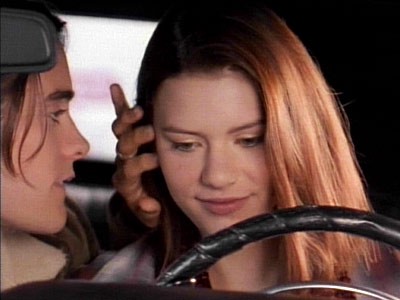
TV — we watch so much of it, it’s only inevitable that eventually we’d want to be it too: time-traveling, crime-solving, vampire-slaying, endless-cheeseburgers-at-Luke’s-Diner-eating heroes. Once while on a particularly grueling rowing trip on the Hudson River, I motivated myself by picturing Pam Beesly’s walk across the hot coals on “The Office.” It worked. We asked a group of the small-screen-obsessed to tell us which TV characters they most wanted to be growing up and/or which ones they wished they could be now. Here’s what they said.
If you weren’t an 11-year-old boy in 1982, you probably have never heard of Phineas Bogg, or the show in which he existed, “Voyagers!” (NBC included an exclamation point in the title, ensuring it would last no more than a season. See also: ¡Rob! and Woops!). Bogg was a presumably immortal member of a secret society of time travelers who had devoted their lives to jumping through the centuries, trying to make right potential historic wrongs. (In one episode, FDR almost becomes a world-famous motion picture director instead of president!) The great thing about Bogg (as played by the late Jon-Erik Hexum) was that he never took his job too seriously. Hell, if anything, he was entirely too casual about his quantum leaps: He treated the fixing of potentially catastrophic wrinkles in time as no more important than fixing a leaky faucet. But that’s what was so great about Bogg. Most of us would probably freak out if we suddenly found ourselves charged with making sure the North still won the Civil War. Bogg? He was totally chill about the whole thing, and usually still found a way to hook up with Marie Antoinette or some other historical hottie. Anybody can time travel, but Phineas Bogg made it seem like the coolest job ever. Sadly, I’m still waiting for the Voyagers Society to respond to my application for employment.
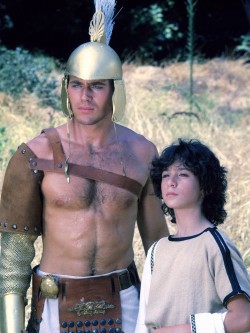
In 1982, I wanted very badly to be Jeffrey Jones — Meeno Peluce’s character on “Voyagers!” Jeffrey Jones was a precocious smart-alecky orphan who is rescued from near death in the first episode by Phineas Bogg, a swashbuckling hunk who belonged to a society of time travelers called Voyagers — they would journey through time to ensure that history unfolded as we know it. Phineas Bogg was played by the the hottest guy who ever was on TV, ever, the late Jon-Erik Hexum. Pretty much the only reason I wanted to be Jeffrey Jones was because he traveled through time with this insanely hot stud. To my luck, I came of sexual age around the time of early 80s “beefcake,” when men were becoming as sexualized for their bodies as women on television. Hexum would wear revealing International Male-style poet shirts, vests with nothing underneath, and sometimes (if the historical era called for it) little gladiator outfits. I yearned to be lost in time with Hexum in a man-boy relationship.
For someone who watches virtually all TV there is, this is a tough question to answer. I considered Leslie Knope of “Parks & Recreation” — a proud feminist, admirable public servant, excellent friend, and waffle enthusiast — but she works really, really hard. Tami Taylor of “Friday Night Lights” is certainly one of my very favorite TV characters of all time, and though she is gorgeous and perfect, I don’t think I’d want to be her; a career in academia is a thankless grind, plus she has kids: no thank you. So I had to go with Malcolm Tucker of the British sitcom “The Thick Of It”. Though he works a lot harder than I care to, and lives in England where the weather and food are terrible (I hear), he has managed something I admire and envy: his main professional duty (as a highly placed aide to the PM) is yelling at whomever he feels like, using as many expletives as he deems necessary, and suffering no negative consequences whatsoever. Is he probably going to die young, of a rage-induced stroke? Maybe. But until then, he will have lived his best, angriest life. Plus in one episode we get to see his flat and it is super-nice.
The only answer anyone should give you is Arya Stark.
The obvious answer for me right now is Tami Taylor, who is my barometer, my lodestar, my moon and my sun in all things parental, marital, professional. But, really, my hair is not nearly good enough.
I think that the televisual ur-me, the fantasy I still hold inside of me somewhere, is Melissa Gilbert’s Laura Ingalls. Less for her endearing spunk and more for her off-putting earnestness, the way she took things real hard in a vaguely narcissistic way. Like when she thought she was responsible for her baby brother’s death and ran away up the mountain where she was cared for and psychoanalyzed by… God, it would seem? Like, God came down to tell her, specifically, that she was good and not at all selfish. That’s kind of my childhood fantasy in a nutshell.
I didn’t know it then, but as a 7-year-old recent immigrant living in Los Angeles, I was learning how to be a good, postmodern American by watching “Wild Wild West” on TV. James West was everything I wanted to be: a secret agent cowboy playing cat-and-mouse with the most diabolical b-movie character actor villains ever assembled. Each week, on a surreal western tableau, West and his trusty proto-vaudevillian sidekick Artemus Gordon would do battle with the kind of steampunk bad guys that would design ultimate weapons controlled by pipe-organ pitch, or imprison you in a giant birdcage that had been nicked from the set of “The Prisoner”.
Looking back, the appeal was all about being genre-bending. It’s like Bakhtin and Foucault were let loose on the Screen Gems backlot. James West was like a trickster god putting one over on dim evil henchmen with his James Bondian gadgets and anachronistic expertise in “kara-tay,” or with the help of celebrity guest stars rounded up from the bar at Trader Vic’s.
In reality I’m probably as insufferable as Frasier or Niles Crane, but I really strive to be more like Eddie the dog.
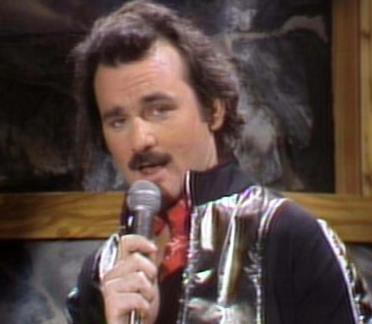
I’m a total TV baby. My first memories are of TV, and I shudder to think how many hours I spent sitting way too close to that screen. So naturally there was a healthy amount of TV hero worship growing up. Johnny Gage from “Emergency!”, T.J. from “S.W.A.T.” , Kolchak from “The Night Stalker”, and of course Fonzie. Everyone loved Fonzie.
But the character that I was most fixated on was the Bill Murray character from “Saturday Night Live”. My folks would play bridge with another couple on Saturdays, so we kids would get to stay up late (late!), which included the obligatory viewing of “SNL” by parents and kids alike. And I remember it all being funny (and no doubt much of it over my head), but that Bill Murray fellow? He really made an impression on little kid me. Sure, the roles he played were different — Nick the Lounge Singer, Todd DiMaLuca (with Gilda as Wendy), Niko in the Greek diner sketches — but behind them all there was this Bill Murray character: blithe yet open, cocksure as if that was the default position, bemused but totally present. I was too young to identify any of those qualities (“He’s really funny,” I would’ve said), but it was not long until I knew that I wanted to be that Bill Murray character when I grew up. (Still do.)
No question about it, I wanted to be Angela Chase from “My So-Called Life.” Angela had that perfect blend of brooding insouciance and sweet, genuine awkwardness that made her the standard bearer for the Manic Panicked among us. I’ll never forget how touched I was by the episode in which Jordan Catalano and Brian Krakow simultaneously realize why they love her (she’s, like, real!) after their English teacher reads Shakespeare’s Sonnet 130 aloud. Angela Chase was real — well, not really real, but real enough for me.

I wanted to be Veronica Mars, or, at least, to possess her crime-solving diligence, bravery, smarts, internal moral compass, and sheer awesomeness. I have a great fondness for pretty much any woman who solves crimes and mysteries (including Mariska Hargitay’s character in “Law and Order SVU”, Emily Deschanel’s character in “Bones”, and all the female DAs on “L&O;”) but I especially love Veronica because she is so very indefatigable and badass — and also, right about nearly everything. Terrible things happen to her: She loses her best friend, she loses her popularity (by choice, to stand by her dad), she gets into scrape after scrape (and they’re not really scrapes but near-death experiences — she’s the victim of violence repeatedly), but despite everything she perseveres. She is a survivor, and not only that, but she’ll get those who done her wrong back, oh yes she will. You do not mess with Veronica Mars, if you know what’s good for you. After all, she’s smarter than pretty much anyone else in her town. And she can hang with the boys.
Other characters I loved were Pacey Witter of “Dawson’s Creek”, who lived a charmed life even when it didn’t seem like it and had a quip ready for every situation. Pacey, the faux tough with the heart of gold… Or maybe I just wanted to date Pacey Witter. Tell no one! I also loved-while-I-hated Brenda Walsh, and who didn’t sort of want to be her and, at the same time, her FOIL, the ever-so-popular-and-pretty Kelly Taylor — at least in the first couple of seasons of the show? And while we’re talking about Shannen Doherty, I know it’s terribly, terribly cheesy, but I would have given a lot, and maybe still would, to be any of the Halliwell girls in “Charmed”, like, just for an evening, perhaps? Spells. Ah, to have spells at my disposal.
I grew up on 80s comedies, looking up to fast-talking schemers like Ferris Bueller, Axel Foley, and Peter Venkman, but there was always one quick-witted Reagan-era smartass who stood above the rest in my book: John Winger, Bill Murray’s character from Stripes. While John Winger was the screen character I always wanted to be as a tween, the closest thing I have to that as an adult is Jeff Winger from NBC’s “Community”, who was named after and patterned after Murray’s Stripes character by “Community” creator Dan Harmon. Both Wingers are quick with a lie when they need to get out of a jam and even quicker with a joke, always prepared to rally the underdogs with a funny and moving halftime speech.
Jeff Winger differs from these 80s movie heroes, though, in that living in the real modern world is forcing him to grow up and leave behind his arrogant ways while still retaining the qualities that make him someone that others want to follow. In real life, we can’t be as bulletproof as guys like Ferris Bueller or Axel Foley because, let’s face it, they’re kind of assholes. What’s fascinating about Jeff Winger is that he’s one of these stock 80s movie blowhards, but he’s learning to mature into a caring human being. Winger is discovering how to be confident without being cocky, how to be a strong leader without being an egomaniac, and that delivering a speech to rally the troops is much more rewarding than doing so because he loves the sound of his own voice. He’s emulating John Winger and Ferris Bueller’s good qualities and shedding away the bad ones. As a kid, movies like Beverly Hills Cop, Ferris Bueller, and Stripes always made me wish I was the main character, but “Community” has taught me there’s more value in being a human being.
I wanna be like a million TV characters. One is Raven Baxter, for her psychic powers and cool attic room. Also, Diane, the person Cooper is always talking to in his tape recorder on “Twin Peaks.” Also, I wouldn’t want to ever be Topanga or Winnie Cooper, but a Savage brother as a love interest would be nice.
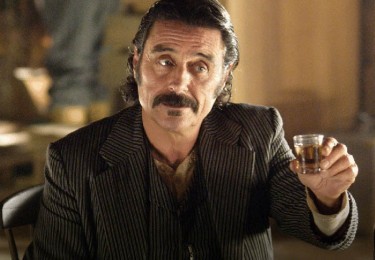
Like most people, I’ve never been interested in any career that would prevent me from insulting people to their faces or saying “cocksucker” a lot. For this reason, Al Swearengen has always been something of a hero to me. On “Deadwood” the man proved, time and time again, that it is possible to run a small business and rally the people around a cause, all the while drinking to excess, intimidating strangers, sleeping with prostitutes, and wriggling out from under the thumb of The Man. In fact, if our politicians were free to make ample rhetorical use of sodomy metaphors, we’d be sure to attract a much livelier, more entertaining pool of candidates. In urging us to stand together against another terrorist menace, wouldn’t it be refreshing to hear Obama ask, “Will we of the United States be more than targets for ass-fucking?” And conjuring Swearengen could help Obama to efficiently address everything from North Korea’s empty diplomatic gestures (“He must think I’m a fucking dog, forgives the blow first friendly scratch at the ear.”) to the ethicality of drone strikes on foreign targets (“You can’t cut the throat of every cocksucker whose character it would improve.”) Best of all, instead of playing the “Star-Spangled Banner” before major events, someone could simply shout, “Open the fucking canned peaches!”
Funny that you’re asking this, as I was asking myself this same question just recently. What I came up with is that probably the only television character I could ever be is Graham Chase from “My So-Called Life.” I think when I was younger I’d have said I wanted to be someone like Jordan Catalano, some brooding, artistic loner who all the girls love. But then you get older and you’re like, “Oh, yeah, Jordan Catalano was a selfish illiterate who never knew what day it was!” Nowadays I like Graham: Just a dude trying to figure out what in this life fulfills him while also trying to do right by his wife and kids. I could get down with that.
MacGyver The stakes are never as high, but I like to think of myself as having MacGyver-like skills when it comes to home repairs. So to actually be MacGyver would take things to the next level. With his skills I could surely dazzle my kids by making explosives out of toothpaste or some such thing
When I was 10, I would have answered with a resounding Lisa Simpson, then gone back to practicing my saxophone, which I totally started playing because of her. The subsequent 18 seasons of “The Simpsons” and puberty have relieved me of that ambition, however. So speaking as Adult Me, I’d have to say Veronica Mars. The idea of having access to the tools of a private investigator appeals to the nosy know-it-all in me, and I’ve always wanted to take someone out with a stun gun. (Let’s just leave out the whole “acquaintance rape” and “in constant mortal peril” aspects, though, shall we?)
If I could be any TV character, I’d want to be Ralph Wiggum. I’d have a cat named Mittens whose breath smells like cat food. I wouldn’t be allowed in the deep end of the sandbox, which, honestly, is something that’s always freaked me out, anyway. I’d have a pre-packaged collection of Star Wars characters, still in their original display boxes (but I’d take better care of my Wookie). I’d have an imaginary Leprechaun to keep me company. I’d play a mean George Washington. I’m Idaho. Best of all, I’d be blissfully unaware of, well, everything, and that sounds pretty great sometimes. In other words: I choo-choo-choose Ralph Wiggum.

Embarrassingly, I kinda wanted to be Seth Cohen from “The O.C.”, nerdy and wiry and a little weird, but still cool and sexy. I think I wanted to be Dana Scully from “The X-Files” for a while, and probably Buffy at some point too. Mostly though, and I know she’s not technically a TV character, but I want to be Samantha Brown from the Travel Channel because she has the best job of any American working today.
Alex P. Keaton, of course. A nerdy, too-smart-for-his-own-good white dork who overcame all of that to be charming, popular and attractive to girls? He was everything I could possibly aspire to be. Even if I never understood all the references to trickle-down economics.
All the shows I currently adore feature people who are insanely flawed and/or living in hellish Medieval warscapes. I don’t want to be Tyrion or Kalinda or River Song, even though I love those characters.
I suppose I’ll pick Leslie Knope, although I could not resemble her less. She’s a role model for humanity without being totally obnoxious, plus she’s dating Adam Scott. Alternately, maybe Max on “Happy Endings”, but not during his yearly hibernation.
As a child of the 70s and 80s, this presents a huge challenge for me. TV in my formative years was chock full of enviable roles. I went as Underdog like three Halloweens in a row. In my 30s. I mean, the smart money’s gonna pick Thomas Magnum (the Ferrari, the shorts), Jack Tripper (the innuendo) or ALF (the cat-eating), right? Or the guys from Riptide? That helicopter!
In the end, though, it’s gotta be Hawkeye Pierce. My father was a huge fan of “M*A*S*H”, so I grew up watching Alan Alda play Hawkeye long before I was old enough to discover the movie. His character was urbane but irreverent, professional but anti-authority; a womanizer, boozer and prankster who also seemed to care a lot about helping war casualties regardless of uniform. He appealed to me as a kid because he got to play Army, and as a pre-teen because he refused to play Army by the rules. His character got a bit preachy in the later seasons, but he had already taught me to put beer in my breakfast cereal, so it’s all good.
Nowadays, as an adult, I’m less envious of the lives of fictional characters like Don Draper or Pauly D. In my rich fantasy life, I would love to be one of the “Mythbusters” or “Top Gear” guys. Boys will be boys.
The first TV character I remember looking up to (who wasn’t a cartoon) was Albert Rosenfeld, the acerbic FBI agent played by Miguel Ferrer on “Twin Peaks”. He came off as a cynical jerk, which was funny, but it was a strange, wonderful scene in which he revealed the deep principles beneath that cynicism that made him admirable to my 17-year-old-self, who was looking for a way out of the unearned cynicism my friends and I had cultivated as a way of life in high school. These days, now that I’ve aged into the role of a crusty editor, I most look up to Lou Grant from “The Mary Tyler Moore Show”. That’s in part because he and I have roughly the same sort of job, but mostly because he possesses a more complex version of Albert Rosenfeld’s outer toughness and inner idealism, a combination that, in my experience, you need if you want to make it in the world while still holding onto your soul. I’d happily be Lou minus the obvious alcoholism and failing marriage (and, well, without Ed Asner’s build and back hair).
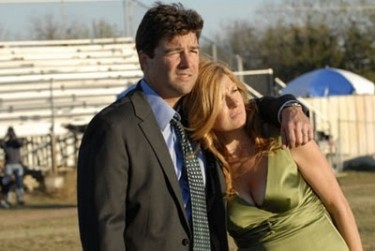
I am sufficiently inadequate as a person that I don’t think I can narrow it down to just one, but if I’ve got to pick: Coach Eric Taylor of “Friday Night Lights”. As I wrote in my review of the series finale, he basically spent the five seasons of the show teaching a seminar in How to Be a Goddamn Man. Stick to your principles. Be loyal but not blind. Pull other people up, not down. Have faith. Give a shit. I could stand to improve on any of those qualities, plus I wouldn’t mind better chin definition and to be able to hold a conversation about sports.
When I was younger, I would always identify with/aspire to be the sidekick characters. None of the responsibility of the leads, who always had to do stuff, save stuff, and put their lives and hearts at risk, but close enough to get some of that reflected glory or the sweet perks that come with being a Very Interesting Person’s best friend. Then Joss Whedon went and poked Xander’s eye out in the waning episodes of “Buffy,” and while I can’t say I ever wanted to be Xander (nerd-surrogate was never my bag), it certainly opened my eyes (ugh, I tried to avoid it, you guys) to the folly of sidekick superiority.
These days, I can’t imagine anyone would want to pass up the life of a Leslie Knope, who manages to be wildly successful in her personal and professional lives without having to do anything mean or morally compromising and who enjoys the unfailing support of a street team who sometimes seem to exist only to see her achieve her dreams. Would I be willing to relocate to Pawnee, Indiana in order to reap such unfathomable benefits? Umm… (Just kidding! I’d be whisked to Washington D.C. within two years anyway!)
Honorable mention: if you’re looking for all of that dogged friend propping-up without the pressure of actual success, you could do worse than Nick from “New Girl”.
Andy Rooney: Growing up a fundamentalist Christian, I wasn’t allowed to watch much TV, but every Sunday night my family gathered around “60 Minutes”. I loved the show, and got teased by my classmates for listing it as my “favorite TV show” in my 8th grade yearbook. But I always shushed my siblings and sat close to the screen at the end when it was time for my favorite segment, “A few minutes with Andy Rooney.””
In retrospect, I was probably just getting observational comedy and a sense of the absurd from any source, but Andy’s annoyance at the things that didn’t make sense about the world appealed to me. I was in awe less of Andy himself than of his job. Many years later, after I wrote some rant on a blog about a topic I’ve forgotten (but possibly about the Charlotte airport, my eternal geographical nemesis), an anonymous commenter, intending malice, wrote, “Move over, Andy Rooney!” I took it as a compliment. I still never miss “60 Minutes”, but it’s not the same without Andy.
As a boy, I wanted to be Buck Rogers on “Buck Rogers in the 25th Century” — the 1978 Gil Gerard character, the guy in the jumpsuit — because he got into cool adventures, had a Mr. Spock-like half hawkman as a best friend, and had Wilma Deering as a girlfriend but could have easily shagged the voluptuous Princess Ardala if he wanted. When I got slightly older I wanted to be Frank Furillo on “Hill Street Blues” because he seemed like the best-case scenario of what a heterosexual male adult could be. While far from perfect (he was a recovering alcoholic and could let his pride get the better of him) he was a great human being: tough but not stupidly macho, blunt but not cruel, and ultimately compassionate. He owned up to every part of himself, including his mistakes. And his girlfriend Joyce Davenport was as cool, sexy and smart as he was.
Summer Roberts (“The O.C.”): Fast-talking, quippy best friend of town lush Mischa Barton with not insignificant — though consciously recognized! — daddy issues who, despite her initial fixation with high-school popularity eventually lands the equally fast-talking, quippy nebbish. The scene in which she and Seth stop at a diner on the way to Mexico and read the paper and butter each other’s toast and pour each other’s coffee without even looking up — oh my gosh! Its importance to my understanding of how ideal relationships should work cannot be overstated. Also she looked bomb in a Superwoman costume that she rented to make Seth swoon! I love a girl who appreciates the (dark) art of a well-timed costume!
Related: What’s Your Most Played Song?, What Movies Make You Ignore Everything Else? and What Books Make You Cringe To Remember
Nadia Chaudhury wants to be a mix of Rory Gilmore, Peggy Olson, and Mrs. Coach.
Woman Dislikes Precipitation
Like all right-thinking people who are fortunate enough to have escaped the dank, vomit-encrusted dagger armory that is Britain, Tina Brown is thankful that she no longer has to deal with that foul island’s repulsive weather.
The State Of The Nation In Four Datapoints

• “Americans love fried chicken. Just like they love chips and dip. So what could be tastier, fast-food restaurants conclude, than chicken you can eat like chips and dip.”
• “Seventeen percent of all meals ordered at restaurants in the U.S. are now eaten in cars, according to NPD Group, a consumer research firm.”
• “ Whereas ice cream or chips used to suffice as a snack, people now want something more substantial like a small sandwich…”
• “Last week Pizza Hut introduced a P’Zolo, a rolled, hot sandwich intended to be held in one hand. It comes with marinara or ranch dip.”
[Source]
If You See An Elk While Peeing In Sweden, Be Careful: There's Sure To Be A Bear Somewhere Nearby
“A 61-year-old Swedish man who was relieving himself in the woods was caught on tape being knocked over by a bear chasing an elk.” The video is kind of amusing if you don’t trouble yourself over the question of why his wife would continue to film the whole time.
Our Billionaire Philanthropists
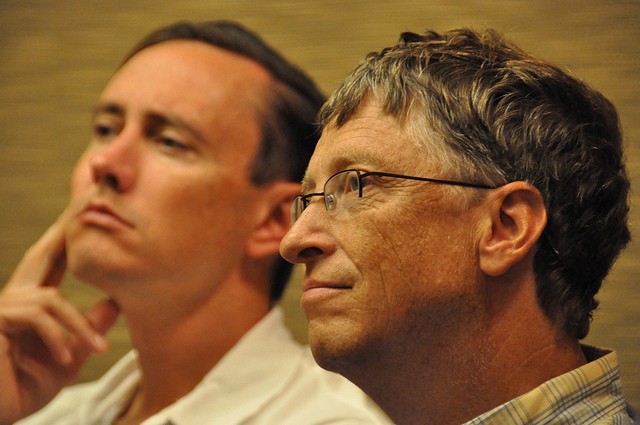
I.
In June of 1889, Andrew Carnegie published his essay “Wealth” in the North American Review: a famous document, as remarkable for the author’s delusional self-regard as it is for the case he makes for private philanthropy. The steel baron launched his argument with the dumbfounding claim that until “the past few hundred years [of human history] there was little difference between the dwelling, dress, food, environment of the chief and those of his retainers.” He then sails blithely along to insist that we should all welcome the changes in society that make violent wealth inequality inevitable, because the benefits of wealth must inevitably trickle down to the least fortunate, etc., an assertion that many of later generations have come to view with a certain skepticism.
Despite the self-congratulatory hallucinations, “Wealth” contains a genuinely noble philanthropic message. The rich man has a duty to live unostentatiously, Carnegie argues — to provide modestly for his own dependents, and “to consider [the balance of his wealth] simply as trust funds, which he is called upon to administer […] to produce the most beneficial results for the community.” He goes on to say, unblushingly, that the man of wealth is the ablest, best kind of man, who should therefore become “agent and trustee for his poorer brethren, bringing to their service his superior wisdom, experience, and ability to administer, doing for them better than they would or could do for themselves.” One may wonder how these last remarks would have been received by the jailed and brutalized strikers of Carnegie’s Homestead Mill.
If Carnegie’s gospel of wealth recalls to you the rhetoric and the general mindset of modern philanthropists such as Bill Gates, Pierre Omidyar, Michael Bloomberg, Sergey Brin and Larry Page, I can’t say I blame you. His Gilded Age vision of the industrialist’s lordly prerogative has survived mostly intact.
This is all the more striking for the vast changes wrought in the American social contract since Carnegie’s time. “There was no social welfare state in the 19th century,” Robin Rogers told me recently; she’s a sociologist at Queens College working on a book about how billionaire philanthropy is shaping public policy. When “Wealth” was published, America had yet to develop a concept of the absolute equality of its citizens, let alone any fixed mechanisms that might ensure their fair treatment in the Darwinian tumult of the industrial age. “The accountability that we expect today was simply not a part of what people thought,” Rogers says; there were no child labor laws, no universal suffrage, and virtually no federal or state programs for social welfare of any kind.
Today’s billionaire philanthropist no longer operates in such a vacuum. The great successes of late 19th and early 20th century philanthropy, such as the transformation of medical education that began with the Flexner Report in 1906, served to pave the way for later, and far larger, government initiatives. But since the 1970s or so, philanthropists have grown less inclined to see their organizations as laboratories for the advancement of the American welfare state; instead, they have increasingly sought to develop projects that compete with, or supplant, the efforts of government. In fact, right-wing funding organizations such as the Koch and Scaife foundations routinely position themselves as the explicit adversaries of government.
So we may now legitimately question whether the “ablest” individuals, according to Carnegie’s formulation, really can serve the needs of the disadvantaged better than the government — which is to say, ourselves, in the form of our elected representatives — can do.
Answering or even asking that question as not as easy as it should be. Very few who work in the foundation world are willing to go on the record with even the most marginal of criticisms. Grad student and foundation researcher Tony Wang was uncharacteristically blunt on this point in an essay in Tactical Philanthropy last July (links in original):
Despite First Amendment protections and the availability of Internet anonymity, feelings of institutional allegiance and desires to avoid conflict, especially with colleagues that we respect and work with every day, cause many of us not to speak up on controversial topics. And because of the unique structure of our sector, where foundations enjoy the power of the purse, criticism of our sector is even harder to come by.
Criticism of organized philanthropy, scarce as it is today, has a long pedigree. In 1891, just two years after the appearance of “Wealth,” Oscar Wilde published “The Soul of Man Under Socialism”, an essay that came down like a sledgehammer on the assumptions of the Carnegies of the world. Wilde contended that charity has the insidious effect of perpetuating the unjust system that gives rise to poverty in the first place. “[As] the worst slave-owners were those who were kind to their slaves,” he wrote, “and so prevented the horror of the system being realised by those who suffered from it, and understood by those who contemplated it, so […] the people who do most harm are the people who try to do most good, while preserving the system.”
And yet there is a telling illustration of Wilde’s own principles of social generosity in action, in an anecdote that the writer’s friend Edgar Saltus told his 1917 book, Oscar Wilde, An Idler’s Impression:
On one occasion I drove with him to Tite Street. An hour previous he had executed a variation on the “Si j’étais roi.” “If I were king,” he had sung, “I would sit in a great hall and paint on green ivory and when my ministers came and told me that the people were starving, I would continue to paint on green ivory and say: ‘Let them starve. ’” […]
Afterward we drove to Chelsea. It was a vile night, bleak and bitter. On alighting, a man came up to me. He wore a short jacket which he opened. From neck to waist he was bare. I gave him a shilling. Then came the rebuke. With entire simplicity Wilde took off his overcoat and put it about the man.
II.
Private foundations pay almost no taxes. In exchange for their expansive tax breaks, they are required to distribute 5 percent of their assets every year. And with wealth consolidating ever upward in America, private foundations are growing like topsy. More than 120,000 such groups controlled around $583 billion in 2010.
Foundations provide about 13 percent of the money given to charity in the United States, a proportion that currently works out to around $41 billion annually. The rest comes from bequests and individual philanthropists — ordinary people who write checks to Doctors Without Borders at the end of each year, or to the Red Cross when there is a disaster.
The total given to charity in the U.S. amounts to about 1.7 percent of GDP, a far higher proportion than in other developed nations. In the UK the figure is about 0.7 percent, in Germany 0.22 percent, and in France 0.14 percent.
With wealth consolidating ever upward in America, private foundations are growing like topsy. More than 120,000 such groups controlled around $583 billion in 2010.
This apparent discrepancy is widely mischaracterized. Howard Davies, former director of the London School of Economics, noted dryly in theGuardian that “with the French it is clear that richesse n’oblige pas du tout.” Mais bien sûr, it should also be noted that the top tax rate in France is 50 percent, not counting an extra moneybags-surtax for high-net-worth individuals, the impôt de solidarité sur la fortune, plus a Value Added Tax of more than 19 percent. These revenues are used to fund, among other things, a first-rate single-payer health system for every French citizen. The French trust in their government, rather than their billionaires, to look after disadvantaged people, and they accept high tax rates as a fair price for those services.
In the United States, this logic has been trending the opposite way for decades. In his 2000 book, The Paradox of American Democracy, John B. Judis makes the case that the American elites who run our large institutions have failed to protect their disadvantaged fellow citizens. Judis blames this failure on “a disturbing decline in the quality of the American leadership class” — a trend that he sees accelerating in the late 1970s and early 80s, when powerful former government officials such as Henry Kissinger and Alexander Haig founded lucrative lobbying organizations, and bankers, lawyers and business leaders began to confine their public activities to lobbying on behalf of their own industries. The noblesse oblige of American elites from FDR through the Eisenhower years has given way to the claims of a class of policy hands for hire, with the greatest intellectual payoff going, essentially, to the highest bidder.
Rich philanthropists are almost invariably described in the press as generous, visionary benefactors; it seems indecorous to complain about a rich man who is apparently trying to give his money away to help people. But the new model of foundation giving comes with a host of hidden costs that bear closer scrutiny.
III.
For all the talk of philanthropists “giving back,” private foundations operate with a generous amount of public assistance, thanks to the tax advantages they enjoy. Witness this telling anecdote from Mark Dowie’s book, American Foundations: An Investigative History (2001), describing a meeting at George Soros’s Open Society Institute:
[T]here was a protracted argument […] Finally, an impatient Soros exerted his authority by saying, “This is my money. We will do it my way.”
“No, it isn’t,” objected a junior member of the staff. A hush fell over the room, and he finished the sentence in a quiet voice: “Half of it is ours.”
“What are you talking about?” asked Soros.
“If you hadn’t placed that money in OSI or another of your […] foundations, sir, about half of it would be in the Treasury,” explained the tremulous youth. “It would be ours.”
Meanwhile, without any significant public claims on foundation largess, the general run of charitable spending in the United States has taken on the protective coloration of American business culture. At every level, charitable grants have come more and more to resemble investment projects, with a specific, measurable return on equity in mind. Among the dozens of sources I’ve interviewed on the state of the foundation world, every one has singled out this trend as a major shift.
Charitable spending in the United States has taken on the protective coloration of American business culture. At every level, charitable grants have come more and more to resemble investment projects, with a specific, measurable return on equity in mind.
The new focus on metrics has brought with it a new breed of nonprofit and for-profit partnerships. Foundations such as the Omidyar Network, established in 2004 by eBay’s founder, Pierre Omidyar, provide both investments in for-profit companies and charitable grants.
This approach is called by various names such as “social entrepreneurship,” “venture philanthropy,” and “philanthrocapitalism,” but it all amounts to rather the same thing: controlling charitable giving in order to produce measurable, “sustaining” and/or profitable results.
“Philanthrocapitalism” is an especially curious coinage, giving rise to a hitherto unarticulated contrast — namely, with the kind of capitalism that is not-philanthro-. Not devoted to loving our fellow-man. And yet most of us grew up hearing that capitalism (the ordinary kind) was supposed to improve our lives. What gives? I asked Robin Rogers.
“The hope is that philanthrocapitalism and capitalism are mutually transforming,” she said.
It’s not clear how this transformation will come about. Since the 1970s, the radical right has steadily stoked up the tension between business and the rest of society; the influential neoconservative Irving Kristol emerged as a key advocate, Judis writes, of the notion that business and government are natural enemies — a condition that practically mandates corporate bodies to purchase ideological influence. Kristol argued in a widely heeded 1977 essay [PDF] that “corporate philanthropy should not be, cannot be, disinterested.”
Today’s right wing continues to push these familiar, if questionable, ideas: that business is good at measuring and achieving set results and goals, while government mysteriously lacks such abilities; that business is pragmatic, efficient and uninterested in ideological point-scoring; that every institution would benefit from being “run like a business,” as George W. Bush, a notoriously failed businessman (and president) described how he intended to govern the nation.
At this moment of crisis, Brinker was left flailing around and citing “metrics” (a repeated mantra in her public statements) as a key reason for the funding cuts, without ever mentioning exactly what it was that needed measuring.
The deficiencies of this reasoning came abruptly to light in the recent contretemps at the Susan G. Komen Foundation, after the famous breast cancer charity announced a plan to withdraw cancer-screening funding from Planned Parenthood. The cuts appeared to be a matter of plain politics, a function of Komen’s opposition to Planned Parenthood’s advocacy for reproductive choice. NBC reporter (and breast cancer survivor) Andrea Mitchell promptly called out the policy shift in an interview with Komen founder Nancy Brinker, who was caught completely flat-footed. At this moment of crisis, Brinker was left flailing around and citing “metrics” (a repeated mantra in her public statements) as a key reason for the funding cuts, without ever mentioning exactly what it was that needed measuring. Public pressure eventually forced the Komen Foundation to reverse course — and to accept the resignation of the conservative Komen Vice President Karen Handel, who had instituted the suspension of Planned Parenthood’s funding in the first place. Even so, the Komen overreach was revealing.
Neither do we lack for instances in which the public-relations value of philanthropy clashes with business imperatives. Witness the case of Daniel Straus, a Connecticut nursing-home mogul who endowed the Straus Institute for the Advanced Study of Law and Justice at New York University — a program that grants qualified fellows a cool $100,000 to pursue research “determined not to be merely ‘ivory tower’ but to merge premier academic and intellectual conditions with community integration and a sense of public service.”
All this lofty merging and integrating occurred, awkwardly, as Straus-owed subsidiary HealthBridge Management locked out striking workers at the company‘s Milford, Conn. facility, the West River Health Center. Workers there were protesting pension freezes, benefit cuts, and cuts in overtime, sick pay and paid lunches. As DailyKos correspondent Laura Clawson noted, “while Straus is demanding that his $32,000 a year nursing home workers give up their paid lunch breaks, his $100,000 a year fellows are provided with a weekly lunch.” Labor, and pressure from the media and the public, eventually forced management to cave. As ever, “power concedes nothing without a demand.”
It doesn’t take much imagination to see that this new blurring of the lines between nonprofit and for-profit activities is bound to create a blurring, also, of the traditional aims of philanthropy — namely, to provide help to the disadvantaged disinterestedly, as opposed to furthering the donor’s business or political goals.
IV.
In the 1940s, The Rockefeller Foundation launched a drive to develop new high-yield crops in order to improve Mexican agricultural productivity. The subsequent explosion of food production in the developing world in the 1950s and afterward, known as the Green Revolution, is now a textbook illustration of the world-changing breakthroughs that philanthropy can achieve — and of the dangers it courts.
The Rockefeller Foundation’s original motives were not purely altruistic; there were strong geopolitical reasons for fomenting the Green Revolution. The leftist government of Mexico had nationalized Standard Oil’s assets at enormous cost to the firm in the late 1930s; when a far more business-friendly administration came into power in 1941, Rockefeller trustees and the American government were keen to prop it up by preventing increased hunger and unrest: Bread, at least, if not circuses.
Rockefeller Foundation researcher Norman Borlaug won a Nobel Peace Prize for his role in this effort; he developed a high-yield dwarf variety of wheat that boosted production so much and so quickly that by 1956, Mexico had become self-sustaining in wheat.
“Self-sustaining,” that is, insofar as domestically-grown crops were now sufficient for the country’s requirements. But the skyrocketing need for synthetic fertilizers and pesticides merely created a different kind of dependency on imports. “These nations became perilously dependent on foreign input suppliers for their food security,” wrote Tom Philpott in Grist. Bumper crops caused prices to collapse, driving family farms out of business. Millions of Mexican farmers were driven out by Big Ag. Philpott: “Since the Mexican manufacturing economy has been nowhere near robust enough to absorb them, a huge portion of one-time Mexican farmers now wash our dishes and harvest our crops.”
The immense social and environmental costs of the Mexican agricultural reforms went unmeasured. Western aid authorities exported the Green Revolution to India, with the same detrimental results: a permanent disruption or destruction of local villages and local agricultural practices; a dangerous loss of biodiversity; huge increases in pollution, particularly in tainted water [PPT]. Again, Green Revolution agricultural practices favored larger farmers, with the result that hundreds of thousands of small farmers were driven from the land, in India as in Mexico. The mass suicides among small farmers in the Punjab are widely thought to be directly attributable to these sweeping agricultural reforms. Measurable results, all right — only they measured “output,” not the number of displaced small farmers or fishing ruined by toxic runoff.
Despite all these metrics, which researchers have collected for more than sixty years, the Gates Foundation has joined forces with Monsanto to bring Green Revolution agricultural practices to Africa.
These problems were evident well before 1971, when the Ford Foundation’s agricultural director, Lowell Hardin, gave a public speech warning that “the green revolution is exerting a destabilizing influence on traditional social and political institutions […] Increased output is not necessarily associated with positive social change.”
And note well that just having enough food doesn’t ensure that the world will be fed. As of 2011, 925 million people were still hungry, according to the World Hunger Organization. Thousands of children in poverty die of hunger in India every day. There is food enough in India to feed their whole population, but not the means of paying for it; the supply side of the equation has been solved, but the demand side has not. Or rather, it has been solved, but in an unintended fashion: Reuters reported last December that India had “sealed deals to export one million tonnes of corn to southeast Asia in the first two months of the season.” Put another way: Export markets may come to trump domestic need.
Despite all these metrics, which researchers have collected for more than sixty years, the Gates Foundation has joined forces with Monsanto to bring Green Revolution agricultural practices to Africa. This time, though, the privately financed initiative is meeting with greater public resistance among a target population by now educated to its likely effects. As Mike Ludwig noted recently in Truthout, African opponents of the Gates initiative have latched onto a recent study by the International Assessment of Agricultural Science, Technology and Development, which found that despite its many productive successes, large-scale industrial agriculture “has caused environmental degradation and deforestation that disproportionately affects small farmers and poorer nations. … Massive irrigation projects now account for 70 percent of water withdrawal globally and approximately 1.6 billion people live in water-scarce basins.”
There is also increasing evidence that sustainable farming practices that do not rely on patented Monsanto products can boost farming output without polluting the environment and without the social disruptions that have unsettled poor communities in India and Mexico. But Monsanto will presumably resist attempts to amend Green Revolution practices in favor of its own profit motive.
The metrics that guide great foundation crusades are very effective when it comes to persuading us that business, and business-trained philanthropists, can do better — but it appears that metrics don’t matter when they conflict with ideology.
I asked Kavita N. Ramdas, a scholar at Stanford, to explain to me why, in light of what we already know about the effects of these reforms in India and elsewhere, the Gates Foundation is still pursuing a new, Monsanto-driven Green Revolution in Africa.
Her response was striking. “I do not believe that the Green Revolution was an unmitigated success for India, given what we now know about the impact of these high yield seeds and intensive agriculture on topsoil, the dependence on fertilizers, pesticides, irrigation and the social effects on small farmers and landless labor in Punjab,” she said. “On this, I clearly disagreed with my colleagues at the Gates Foundation, who argued that the benefits of the Green Revolution in addressing hunger outweighed the costs.”
Still, she notes, the foundation’s new Africa alliance with Monsanto came about due to the culture of the metric return rather than via any malicious design. “The Gates Foundation is far from being a caricature of an evil empire. In fact, it is a foundation with extremely good intentions. I see these as the natural inclinations of a foundation so closely affiliated with a tech company that believes in the importance of measurable impacts.”
Ramdas went on to suggest that the econometric model of philanthropic activity may come with dangerous blinders. “At the root of the difference in approach is what we believe causes hunger or poverty. If you think that people are poor because there is not enough food, then you will concentrate on making measurable gains, in growing more food, and more nutritious food, more efficiently. But if you think that people are poor because of problems with equality, with access, with education, then developing a concrete strategy is far more difficult; these things are not readily measurable.”
V.
Another trend in philanthropic giving is, on the other hand, alarmingly measurable: The blatant purchase of a new Mandarin class of intellectuals to do the ideological bidding of their funders.
A striking example of this pay-to-play brand of academic research came last year courtesy of the right-wing petrochemical billionaire Koch brothers. Writing in the Tampa Bay Times last May, Kris Hundley reported that the Charles Koch Foundation had pledged $1.5 million to hire new economics professors at Florida State University, on the condition that the Kochs do the hiring themselves. Amazingly, the university agreed to permit the foundation’s advisory committee to select the candidates vying for a teaching slot — and to withdraw the money “if the hires don’t meet ‘objectives’ set by Koch during annual evaluations.”
The Koch brothers fund projects at many other universities large and small, including Clemson University, Brown University, Troy University and Utah State.
The Koch brothers fund projects at many other universities large and small, including Clemson University, Brown University, Troy University and Utah State. And when it comes to the ideological vanity of mogul donors, the personal is most definitely political: ThinkProgress reports that some students in Koch-funded programs are required to read Charles Koch’s book, The Science of Success. The Kochs are also key sponsors of the Mercatus Center at George Mason University, whence came the environmental deregulation policies of the Bush years.
These activities are not recognizable as philanthropy; they merely lend a benevolent gloss to ideological advocacy. The same methods are employed, with much the same results, by right-wing ideologues such as Richard Mellon Scaife and Richard Viguerie — the so-called “funding fathers” of the modern conservative movement.
Here is the ultimate result of Irving Kristol’s exhortations against “disinterested” giving: Without any functional oversight — and indeed with the open collaboration of our academic institutions — foundation spending is seeking to delimit the parameters of American public discourse. This kind of “philanthropy” works toward its own vision of a social order — often, a social order in which the philanthropists stand to benefit materially themselves. And nary a bowl of soup or an overcoat in sight.
VI.
The foundations-idea complex has also set its sights on remaking another of the key institutions of our democracy — the public school — in its own managerial image. There’s no other way to account for the distorted, counter-empirical shape of the American debate over education.
In stark contrast to the parents of America’s public schoolchildren, the Broad and Gates brass won’t be at risk for the failures of their efforts, since they will continue to send their own kids to expensive prep schools.
The overarching trends are plain enough: As wealth inequality swells, so do the coffers of private foundations, even as the recession has caused government budgets to shrink. As long as the motives of government and foundations are aligned, that’s not necessarily a problem. But the funders of education reform seek nothing less than the wholesale retooling of public schools, at a time when the nation’s school budgets are stretched to the breaking point. And the writing on the chalkboard grows clearer by the minute: Their market-based educational reforms don’t work.
Arne Duncan, our current Secretary of Education, is a former board member of the Broad Foundation. This aggressive organization’s mission statement is “to dramatically transform urban K-12 public education through better governance, management, labor relations and competition.” Does anybody remember asking some rich guy to do all that?
The Broad Foundation — together with its partner the Gates Foundation — has been trying to shove charter schools and high-stakes standardized testing down the throats of American parents for more than a decade. In stark contrast to the parents of America’s public schoolchildren, the Broad and Gates brass won’t be at risk for the failures of their efforts, since they will continue to send their own kids to expensive prep schools — a practice David Sirota characterized in Salon as “governing from behind palace walls.”
The kicker is that the public ends up paying the lion’s share of the tab for these experiments in educational reform. Government investment in charter schools alone came to nearly $15 billion in 2010, according to a November report in Bloomberg News. Here’s a brisk summary of our return on investment, courtesy of Dissent writer Joanne Barkan:
Stanford University’s 2009 study of charter schools — the most comprehensive ever done — concluded that 83 percent of them perform either worse or no better than traditional public schools […] Gates and Broad helped to shape and fund two of the nation’s most extensive and aggressive school reform programs — in Chicago and New York City — but neither has produced credible improvement in student performance after years of experimentation.
Meanwhile, the school reform movement’s insistence on “merit pay” and “performance-based compensation” consign the nation’s already underpaid teachers to permanent job insecurity. And that, in turn, helps prompt the talented young people whom we could be paying to fix this mess to stay away from teaching in droves. The real miracle is that we have so many great teachers left, who stay in their punishing, frustrating jobs out of a spirit of actual, not pretend, philanthropy.
And all the while, there is a clear explanation for why American schoolchildren aren’t doing as well as they might. Consider the experience of the nation’s largest state economy. California’s 1978 passage of Prop 13 gutted funding for state schools. At that time, California schools were among the nation’s best. By 2011, the National Assessment of Educational Progress ranked California’s fourth- and eighth-graders 46th in math and reading. Those years saw most programs in the arts, music and drama cut away, class sizes skyrocket, and teacher salaries and benefits sliced to the bone. Somehow, these metrics seem never to have crossed the transom at the Gates Foundation, or troubled the California-based policy sachems at the Broad shop.
Yet the de facto privatization of public school policy is only growing more firmly entrenched. The Broad Foundation continues to sponsor training and job placement for dozens of school superintendents across the country — and continues to pay them a Broad stipend even after they’ve found jobs and are on the public payroll.
VII.
There’s no oversight in the spending of foundation money. The communities and individuals affected by foundation spending typically have no influence on it at all. This isn’t especially surprising, when you consider that the modern entrepreneurs who establish foundations have typically acquired an allergy to transparency; the best known philanthropists in our age, after all, are Bill Gates, a ruthless monopolist, and George Soros, a hedge fund manager. According to the cult of the alpha executive, the effective business leader makes decisions unilaterally and brooks no opposition. This model of decision-making may pose few real threats when it comes to peddling a terrible Web browser, or inflicting Mr. Paperclip Man on the hapless user of Word. But the public should take note when a billionaire philanthropist‘s tough-guy decision-making effectively sets social policy in ways that can alter the life chances of millions of other people.
The Gates Foundation’s efforts against malaria, for example, may end up doing more harm than good. An apparent rebound of malaria in Senegal last year speaks ominously to former WHO malaria czar Arata Kochi’s warnings against the Gates Foundation’s monopoly on malaria research and policy back in 2008; the Senegal study, published last year in the Lancet, found not only an increase in insecticide-resistant mosquitoes, but also rebound infections in older children and adults. That troubling trend suggests that some Senegalese may have lost their acquired immunity in the years they’d been sleeping under pesticide-treated nets, which the Gates Foundation has been distributing by the millions in Africa. Malaria expert and science writer Sonia Shah laid out the issues for me in an email:
I think the lesson of history is pretty clear that if economic and other conditions remain the same, malaria resurges when control efforts flag or fail. There is certainly growing evidence that this is happening now. […]
The trouble with malaria is that it fluctuates naturally from year to year and is caused by a multiplicity of factors (climate, geography, housing, people’s immune status, population movements, etc. etc.) that also fluctuate year to year. So to really determine that a decline or resurgence has occurred, you have to measure in decades, not years. Just a few months ago, for instance, the headlines were all about a 40 percent drop in global malaria mortality; today the headlines are all about a huge increase! There’s a lot of hype about malaria, mostly because of the quest for funding, which is a mess right now.
I and others had warned that if the massive scale-up that Gates and Roll Back Malaria were so proud of wasn’t maintained that lives would be lost due to resurgence. Malaria is like a coiled spring; you can depress it by sitting down on it, but as soon as you get up, it jumps back up.
VIII.
Returns are also diminishing on that much-ballyhooed innovation in foundation-backed international aid, the “microloan” organization. These groups finance fledgling entrepreneurs in the developing world, and it now seems as though they have mimicked the practices of Western financiers all too closely: Reports indicate that many have been hamstrung by corruption, political infighting, and an international investor class that doesn’t care where its next fast buck comes from. Nobel Peace Prize winner Muhammed Yunus, the Bangladeshi microlending pioneer behind the Grameen Bank wrote a scorching op-ed piece in the New York Times last January: “Sacrificing Microcredit for Megaprofits,” his argument neatly summed up in the headline.
“Poverty should be eradicated, not seen as a money-making opportunity.”
In Yunus’ account, the downward turning point in microfinance came when the programs attracted large-scale investors pressing to realize rapid returns. Once microfinance IPOs were launched in Mexico and India, Yunus noted, reports began to emerge of poor borrowers being harmed (that is to say shaken down, both literally and figuratively) as philanthropy gave way to the need to show quick profits. “Poverty should be eradicated, not seen as a money-making opportunity,” Yunus observed dryly.
Philanthropy, philanthrocapitalism, profiteering, ideology: what does it matter what we call these things, when people’s lives are wrecked as the result? Measured in terms of the scale of potential harm, the ordinary plutocrat’s indulgences — megayachts, chalets in Gstaad, private jets and bunga-bunga parties — appear positively noble by comparison.
But there are notable exceptions to these patterns; there are foundations that practice transparency and accountability while pursuing economic justice. Those whose mission statements dictate that they serve a local community, for example, are perhaps more likely to consult with that community.
Emmett D. Carson is the head of the Silicon Valley Community Foundation, the 38th-largest foundation in the United States, with assets of more than $2 billion. Carson is a charismatic and optimistic leader, and can cheer up even the most jaundiced student of institutional philanthropy in just a few minutes’ conversation. The calm, orderly, modest offices of SVCF in Mountain View are situated not in a sterile office complex, but in a busy, pleasant street in the middle of town with lots of small businesses — beauty parlors, yoga studios, and a terrific hamburger place called Clarke’s just down the street. The SVCF works on local issues including education, immigration, and economic security issues such as foreclosures and payday loans. Officials with the organization go out into the community, talk to people, investigate directly, and work to implement hands-on remedies.
Carson is hopeful about the new generation of philanthropists. “If you look at the history of philanthropy, of Carnegie and Rockefeller, they weren’t philanthropists as young men; they did nothing like this until the ends of their careers.”
“Cracked a lot of heads first,” I noted.
“Exactly. And I talk to young people in their twenties, who have amassed wealth and they want to put it to use now, in their lifetimes; they may have employees overseas; they have a global perspective. That is forward motion.”
Is philanthrocapitalism also forward motion? I ask. Or an emerging threat to philanthropic work?
“I don’t see these things in terms of a threat. There are for-profit corporations that are good actors, and there are nonprofits that really shouldn’t receive a dime, because they are not doing good work. So it’s really a matter of people finding new ways of working together to make things better.”
Sonia Shah likewise contends that the global philanthropy can be improved through innovation. In last November’s Foreign Affairs, she outlined a strategy for developing partnerships between business and global health organizations such as the WHO, by encouraging more natural partnerships between industry and philanthropy.
Private sector involvement should be expanded to include those companies whose financial interests directly align with those of global health. In addition to mining companies, the fight against malaria could, for example, include insurance companies and tourism operators who will reap long-term profits from healthier customers and less fearful tourists. Similarly, the battle against [noncommunicable diseases] could enlist the participation of local farmers and ranchers whose businesses will grow more nutritious, locally sourced whole foods and sell them to more people. Private companies like these, with health-aligned business interests, are much more likely to realize the promise of private-public partnerships than those that have damages to hide.
An important corollary of this movement toward greater local control would be tighter strictures barring ideological and business advocacy outfits from disguising themselves as philanthropists. And for such measures to take hold in any meaningful way, the media and the public will resist the efforts of foundations to interfere with the legitimate operations of government, while also resisting the efforts of foundations aimed at gaining advantages for a narrow class — particularly within the media itself.
The admonitions of Theodore Roosevelt bear repeating in this regard; in one of his innumerable battles with Congress over new business regulation, the first modern president of the bully pulpit announced in 1905: “[T]he most direful among the influences which have brought about the downfall of republics has ever been the growth of the class spirit, the growth of the spirit which tends to make a man subordinate the welfare of the public as a whole to the welfare of the particular class to which he belongs, the substitution of loyalty to a class for loyalty to the Nation.”
In other words, what‘s needed most of all is a recognition that philanthropy must do more than provide charity, as Oscar Wilde suggested in 1891. Foundations still need to supply the desperately needed overcoat, as Wilde did himself, and do whatever they can to address the immediate needs of people in distress. But the real task is to come to grips with the reasons why so many people are left out in the cold in the first place.
Related: The Evil Economics Of Judging Teachers
Maria Bustillos is the author of Dorkismo and Act Like a Gentleman, Think Like a Woman. She received invaluable assistance on this piece from Chris Lehmann. Photo by jurvetson.
You Were Warned About Hakkasan

Remember back in early 2011, when we warned you that Hakkasan was coming to New York City and that it would be crazy-expensive and full of the snootiest weirdos and serve very good food in general but less so in the specific? It’s always gratifying being right: “Nothing I tasted at Hakkasan was unpleasant, but when the check easily surpassed $100 a person, it was hard not to feel cheated,” writes the Times restaurant critic. Boom, one star.
New York City to Legalize Sunday Brunch

From this morning’s press release on BRUNCH:
Authored by Council Member Dan Garodnick, the bill will allow sidewalk cafes to open at 10 a.m. — two hours earlier — on Sundays. Restaurants today are prohibited from opening their sidewalk cafes before noon on Sundays, despite being able to open in the morning every other day of the week. “New Yorkers will not be denied their Sunday brunch in the beautiful weather,” said Council Member Dan Garodnick, Chair of the City Council’s Committee on Consumer Affairs. “This regulation is outdated, widely disregarded, and hostile to business and brunch-loving New Yorkers. It needs to change.”
Ooohhkay. What’s next, allowing dancing in bars?
